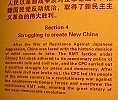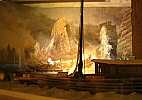Beijing Trip 2009
Nov 20 through Nov 29
Tour of the National Museum, Beijing
I was reluctant to go to Beijing and the Great Wall.
- Not wanting to give any more of my nickels to the Chinese Government, I hesitated for many years -
- The Great Wall, the "national grave yard of China" during its construction, is a monument to the cost and failure of static defense - among other things, the Mongols bribed their way through it at will.
- However, since most of what I buy, except gasoline and food, is now made in China, a few more of my nickels is small change.
And on a larger scale, apparently the average of 100,000,000 American workers/taxpayers owes an average of $8,000 to the Chinese Government via U.S. bonds - and Obama had just gone to Beijing to try get the Chinese government to buy even more U.S. bonds, notes, and what ever :-|
So we got:
- a round trip on China Airlines (owned by the Chinese Government)
- a bus trip and little tour of the "Great Wall"
- a guided tour of Beijing for 2.5 days, (didn't see any of the universities)
- a day in the "Forbidden City". (a PBS presentation engineering aspects of the Forbidden City on YouTube)
- and stayed in the Jade Palace Hotel for 7 nights
- enjoyed a concert in the famous National Centre for the Performing Arts (China)
- I remember that 2 of my high school classmates were killed by
Chinese as the Chinese chased the Americans out of North Korea after
North Korea (with Soviet help and weapons) overran South Korea.
(There was no "peace treaty" to end the war, a cease fire still is usually observed, except when it isn't:
fire fights and tunnels under the "Demilitarized Military Zone", armed night landings on the South Korean coast, and of course the Pueblo 'Incident'. ) - Now we are asking our good friends, the Chinese, to ask North Korea
to stop developing atomic weapons. - no kidding -
Eight years later, 2017, we are still asking the Chinese to encourage the North Koreans to not shoot ICBMs at/near their neighbors (and us). - I visited the Hong Kong and Guangzhou areas twice about 15 years ago - and was curious about the reputed economic, political, (and street traffic ;-)) changes in China during the past 15 years.
Executive Summary: - big changes ;-))
| Poster from the "Red Guard" era - 1965 -
source
when Mao was trying to purify the
masses - Estimates of deaths from various causes, beatings, executions, starvation, escape attempts,
... range in the 10 to 20 million Chinese. For instance, the Zhaoqing
public park was bare dirt, the grass had been converted to grass soup, and yet the hunger got worse -
Terrible times, the Soviets had done the same exercise on their "rural masses" thirty years earlier. And dig those western style tractors, with AllisChalmers colors - farming in China is largely intensive, with small plots, not the Kansas style farms by the square mile with tractors required. | 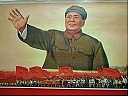
| Ad campaign in 2009 Beijing taxis. - Some now regard China as the last bastion of Capitalism | 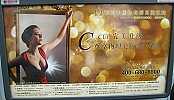
|
National Museum of China
National Museum of China 
Photo from web site left, on a clear day ;-))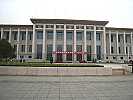
Our viewAfter the 2.5 day guided tour, we took the subway system from the hotel area to get to Tian'anmen Square and the museum. My knees were still sore from scrambling about The Great Wall. The long subway stairs (few escalators) were no fun at all !! A trip anywhere in the vast system costs 2 yuan (about 30 cents currently). We did the trip off peak hours, and even got to sit :-)) -
A bit of "history" The Chinese government under Mao did engage in quite a bit of bombast - the U.S. was Running Dog Capitalist Imperialistic and so on - However, the Qing Chinese in the 1800s did have a hell of a time with real live imperialistic powers. Let's pick on the Brits - as guilty as any -
After muscling their way into Hong Kong in the early 1800s they wanted to use opium as a trade article - against the law in Qing (and current) China. The Brits went to war over this ( with "gun boats" and soldiers, the whole 9 yards ) and forced a number of treaties extremely favorable to the Brits. Well OK, the Brits got everything, the Chinese got screwed. Soon the French, Germans, Japanese and others wanted (and got) a piece of the action. Opium in; tea, silk, etc out - The Chinese were not, and are not, amused by this history.
You can start at http://en.wikipedia.org/wiki/Opium_Wars and http://en.wikipedia.org/wiki/Boxer_Rebellion
Well - yes - even American gun boats, and The Sand Pebbles the book. :-|
OK - back to the very un-crowded museum - I'm skipping whole walls of pictures of the above resistive efforts and pictures of Chinese heroes. In the U.S., Sun Yat-sen gets very good press for FINALLY ridding the Chinese of 2,000 or so years of emperors which in "our" Western view did little for the people other than tax them into poverty to support a life style that even a Muslim suicide bomber can hardly imagine. ("Any one here I haven't offended yet?") Here is a poor reproduction of a not good image of the widow of Sun Yat-sen 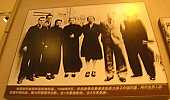
Ah Yes - about the Chinese involvement in WWII against the Japanese, Yes indeed.
- The U.S. complained all during the war that the Nationalists (Chang) and the Communists (Mao) spent most of their time and energies and U.S. supplies - fighting each other rather than the Japanese.
- I looked hard in the museum for any hint of say
Possibly there was text about the above - but the pictures unrecognizable unless you knew what you were looking for - and most folks in a museum don't read unless near an interesting item or picture.
- the Burma Road (built and used to truck supplies into China) - nothing
- the Flying Tigers (U.S. pilots that harassed the Japanese in their P-40s) - an almost unrecognizable picture in a hard to see place
- the air lift "over the hump" supplying over half a million tons of war material against the Japanese - a picture that might have had the back end of a C-47 in it?
- the airbase that was built at Chen Du Operation Matterhorn for B-29 usage against Japan - nothing -
I suppose the above will get this web site "banned/blocked in China".
Here is my biggest surprise in the museum - I couldn't imagine that a Beijing museum would show these two old comrades together - Chiang Kai-shek Mao Zedong
Shortly after the defeat of Japan, these two guys tried to patch up their differences, for the last time.
"The Long March" was of course an "interesting time" in the life of Mao and comrades !! The museum had a good animated map of the various episodes and complexities along the way - but I didn't get a picture :-(( 
Mao's radio
shoes worn by Mao
Mao's binoculars
Chang is gone, civil war over, need a national flag. Here are the displayed contestants, And the winner is in the middle -
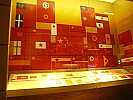
I was too upset to photograph the plaque proclaiming China's glorious victory over the Americans in the Korean War (or police action) in December 1950, at the Battle of Chosin Reservoir. The Chinese, using night marches, had succeeded in moving large forces to the North Korean border. They crossed into North Korea and surprised the strung out Americans who thought the war was about over. According to the article, 60,000 Chinese surrounded 30,000 Americans and pushed the Americans back.
A few years later, 1954, when I was in the American army, I got to know a sergeant who claimed his life was saved by a full bird colnel. According to the sergeant, the American army was in full retreat from the "Chinese hordes". He and many others were walking day and night to get back to the safety of reserve American forces. Life was tough - short of food and long on fatigue. The sergeant said he eventually fell down in the snow and decided to get some rest. He did not feel cold - just wonderful relief - and went to sleep.
He became aware that someone was kicking him - HARD - it didn't hurt, but the kicking continued. The sergent decided to wake up, then get up. The hard kicking continued until he was standing fully up.
A full bird colonel had been kicking the sergeant - yelling at him that if he didn't get up and walk he would freeze to death, like so many others.
The sergeant started to walk again, and continued to walk, to live to tell the story.
This was the same year China conquered Tibet. (Probably a glorious battle against unarmed farmers and monks.) A hiking acquaintance of mine (Galen Rowell) was in Tibet in the 1970s and photographed some Chinese big guns behind a wall by climbing a nearby cliff.
Here is another self congratulatory, "We Are Wonderful" plaque 
And a view through a window of Tiananmen Square at the 56 columns representing the happy 56 minorities in China. The window is not dirty, the outside air is.

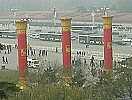
I hear that the Tibetans, Muslims, and Mongols may not be all that delighted with the Beijing government -
Our guide was delighted that China is making its own aircraft. I mentioned that these looked a lot like the Soviet MIG 17 
Here is a Chinese computer, circa 1959 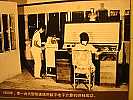
Many pictures seemed stylishly out of focus - I REALLY wanted to get more detail - but what you see here is about all you see in the museum.
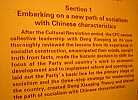
I just love the wording of this last panel - ending in " ...and blazed the path of socialism with Chinese characteristics. The "Chinese characteristics" may now be called "Rampant Capitalism" ;-))
This page originated Nov 28, 2009
updated Oct 20, 2017 with YouTube of the Forbidden City




